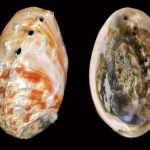Nacre Toughening Due to Cooperative Plastic Deformation
Among biological materials, mollusk shells have been extensively studied for their outstanding combination of stiffness, strength, and toughness. The shell is a composite, primarily made of two different polymorphs of calcium carbonate: calcite and aragonite, with the outer layer being composed of calcite prisms and the inner layer—nacre—having a “brick-and-mortar” structure. The shell’s outstanding mechanical properties have been mostly attributed to the interplay between aragonite platelets and organic matrices. Here, we show that crystallographically co-oriented stacks of aragonite platelets, in both columnar and sheet nacre, define another hierarchical level that contributes to the toughening of nacre. By correlating piezo-Raman and micro-indentation results, we quantify the residual strain energy associated with strain hardening capacity. Our findings suggest that the aragonite stacks, with characteristic dimensions of around 20 µm, effectively store energy through cooperative plastic deformation. The existence of a larger length scale beyond the brick-and-mortar structure offers an opportunity for a more efficient implementation of biomimetic design.
Learn about our two Decals!
 Click here to find out more about our Fall Bioinspired Design Decal and our Spring Bioinspired Design in Action Decal – ALL MAJORS are welcome.
Click here to find out more about our Fall Bioinspired Design Decal and our Spring Bioinspired Design in Action Decal – ALL MAJORS are welcome.Berkeley BioDesign Community
 Click here to learn about the BioD: Bio-Inspired Design @ Berkeley student organization or here to signup for more info.
Click here to learn about the BioD: Bio-Inspired Design @ Berkeley student organization or here to signup for more info.Search
Student Login




I imagine that the neurological circuits underlying these processes are governed by both 2d spacing maps with their brains as…
to reduce the impact of car accidents, it may be possible to study the force diverting physics of cockroaches to…
you see this type of head-bobbing stability in many avian creatures related to pigeons like chickens. the head ability to…
not like they taught horses how to run! this is an example of convergent evolution where both sea creatures and…
The brain functions in a similar way with neuronal connections. our brains are able to utilize the multiplicity of connections…